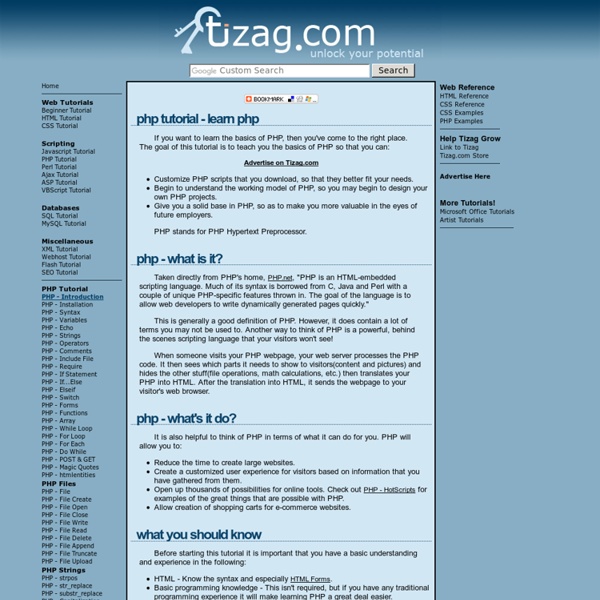



PHP Tutorial PHP Function Reference PHP: Hypertext Preprocessor Lazarus: Form Recovery :: Firefox Add-ons PHP Scripts & Programs - Free and Commercial PHP Scripts TinyWebGallery A free php image gallery that can everything you need and nothing you don't. Rated 4.42 out of 5 (524 total ratings) phpWebSite Open source community-driven Webware featuring blog posting, web page generation and more. Rated 4.23 out of 5 (494 total ratings) Gallery A powerful, intuitive community-based photo gallery. Rated 3.95 out of 5 (251 total ratings) PhotoPost PHP Photo Gallery (w/ vBulletin Integration) Full featured PHP based community photo gallery.
15 Best Resources To Learn PHP Online PHP is the scripting language can be embedded into HTML , used for develop web applications. Every type of websites can create with the help of this language. This language can run almost on every operating system and platform. Java, .Net, Perl and many more are language used for creating websites with its different and useful functionality. PHP language have some popular features and functionality which makes it popularity among developers. Online tutorials always being popular among internet users. their are number of websites to help providing designs and development tutorials which help to learn different everytime. Today we have listed 15 best website to learn PHP online. 1) PHP.net 2) PHP Builder 3) Deniweb Forum 4) W3Schools 5) Stack Overflow 6) PHP Edit 7) PHP Designer 8 ) Zend Studio 9) WikiBook’s PHP Books 10) PHP Tutorials 11) Developer Tutorials 12) 9Lessons 13) Hot Scripts 14) PHP Freaks 15) Big Resouces
jQuery: The Write Less, Do More, JavaScript Library Use OfficeTab To Give Microsoft Office Firefox-Like Tabs I got a hot tip today on a piece of Chinese software that will make my life MUCH easier by adding Microsoft Office tabs to your installed MS applications. Have you heard of OfficeTab? Well if you are not into finding the latest and greatest software you have probably never heard of it. But I am here to show you what it is, how it works and how to grab it. Interested? Good, I thought that would spark some interest! Feel free to download OfficeTab from this link. So the direct download link lives here which, if you scroll down to the bottom of the product page, is the only link there. After downloading the application you have to install it. Simply check the Microsoft Office Applications you want OfficeTab to add Microsoft Office tabs to. These are the Excel settings which start with the check box to enable the Microsoft Office Tabs inside Excel. The other tabs include WordTab and PowerPoint Tab – they are essentially identical. Wow just like Firefox! Let’s see how it works in Excel:
PHP and MySQL Tutorial - Lesson 1 Open source has brought a lot more than Linux to the computing world. It has also given us PHP and MySQL. In the first installment of this three-lesson tutorial, we cover everything you need to know to begin developing database hubs. You’ll get instructions for installation on both Unix and Windows, and then you’ll learn some simple scripts that will insert information into a database and display that data on a web page. Lesson 2 covers more PHP/MySQL goodies than you could probably imagine:while loops, the ever-useful if-else statement. But this information alone means little if you don’t continue and see how PHP can be used with HTML forms. In Lesson 3, you’ll learn some of the secrets that will turn your simple data-driven site into a useful application.
PHP 101: PHP For the Absolute Beginner [box] For a complete list of Zend Training Courses – PLEASE CLICK HERE ! [/box] This area is intended for everyone new to PHP. If you came here to learn about elementary PHP 4 or basic PHP 5, this is for you. PHP 101 (part 1): “Down the Rabbit Hole” An introduction to PHP’s variables and operators.PHP 101 (part 2): “Calling All Operators” The rest of the PHP operators (there are many), and simple form processing.PHP 101 (part 3): Looping The Loop Basic control structures explained.PHP 101 (part 4): The Food Factor Arrays, PHP array functions, and what it all means.
CgiScripts The cgi module is part of the core library of Python. The simplest CGI script that can be considered interesting involves printing out an HTTP header ("Content-type: text/html") and a Web page. In addition, you might want to handle any incoming inputs from things like HTML forms or request parameters. In the earliest days of CGI, shell scripts were sometimes used to do things like this, so the principles are not particularly advanced. Configuration It can be an annoying experience getting the permissions just right on a script so that Web servers like Apache will run it, but the following checklist may be of some use: Find out which user runs the Web server - it's not often the same one as your own user, and it may be one with very limited permissions. In addition you should make sure your script has the correct **line endings** for your server. Sample Code The following code attempts to combine simple output of a Web page with the processing of input from users viewing the page. See Also
Notely : Student Organisation Made Easy